What Kind of Electric Guitar to Play Like Chet Atkins
Too known as the "Country Admirer," Chet Atkins was one of the people responsible for creating the legendary Nashville sound. Atkins was an artist that defined the music manufacture and the evolution of so many genres with picayune knowledge or even credit as he moved forward in his career.
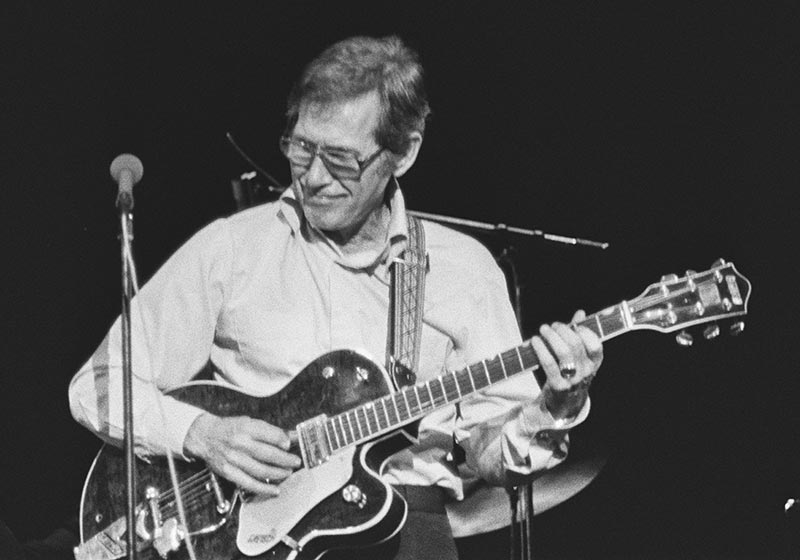
Chet'south first introduction to a stringed instrument began when he was barely a teenager when his mother gave him a ukulele, which he outgrew before moving over to the dabble. These early on toys would serve a younger Chet to bargain his offset guitar, which he got from his nine-year-quondam brother in substitution for some chores and his fiddle with an one-time pistol.
As Atkins grew older, he would practice his own style while he was in high school, locking himself in the bathroom mainly because "it had good acoustics". He would reportedly help local concerts and bar performances if possible during his time in Fortson, Georgia. However, his very first guitar was a semi-acoustic one, he'd walk many miles to plug into an amplifier, given the fact that his home had no electricity. But it wasn't until 1939 that Atkins wouldn't consider himself a solid guitar role player, he credited Merle Travis every bit the one influence that inspired him to innovate his technique.
Atkin'due south groundbreaking approach towards guitar equally a creative automobile, whether it was accidental or intentional, Atkins helped redefine even the craftsmanship a luthier should consider when manufacturing a 6-cord. Furthermore, to this day Atkins remains a subliminal influential figure in Rock music and whatsoever other string fused genre. His mark extends from his brilliant fashion, and all the way to his very proper name.
What Guitars Did Chet Atkins Play?
Chet Atkins is most known for playing Gretsch guitars, of which he had several signature models with the make. Near notably was his Gretsch Prototype Streamliner 6120 Country Gentleman model. Atkins also played a wide range of other guitars throughout his career, including signature models with Gibson.
See the full list of Chet Atkins guitars and gear beneath.
Gretsch Streamliner 6120 Prototype
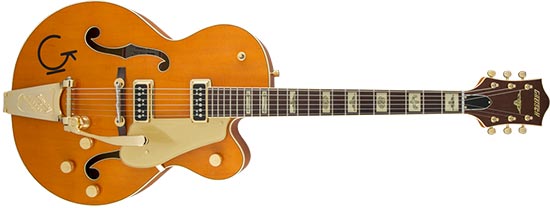
| Stop | Natural Orange |
| Years Used | 1953 to 1996 |
Chet's bear on grew as a remarkable guitarist during the early on 50s, and then it was just a thing of time before he eventually got his get-go endorsement deal. In the mid-1950s, Gretsch and Atkins started collaborating on this new instrument. All of the features were designed past Gretsch and the musician gave his approval. The Streamliner 6120 remains ane of the visitor'due south legendary models if not the most successful Gretsch guitar ever issued. Chet's image is known as the original "Country Gentleman". Needless to say, it also served equally a pattern to his future guitar models and 1 of the nigh popular signature lines to ever exist.
At the get-go glance, the instrument is obviously very much Western-inspired. But bated from visual features, this one had an arched acme and an arched back, which isn't and then common these days. It's a unmarried-cutaway hollow-body instrument with two large F-shaped soundholes. The top was made of maple and featured a natural cease with its orangish shade. As far every bit pickups go, the musical instrument had single-coils, the DeArmond Dynasonic ones. This comes as no surprise as Gretsch used these exclusively dorsum in the day.
It as well featured a scale length of 24.five inches and 22 frets. There was besides a Bigsby B6 tremolo tailpiece, accompanied by a regular tune-o-matic bridge placed on a wooden base of operations. But, above all, information technology featured some pretty exciting visual details, including a steer-caput inlay on the headstock, as well as cactus and steer inlays on its rosewood fretboard. Finally, information technology also had a specially designed "G" logo near the bass-side F-hole.
Equally it usually goes with Chet Atkins' guitars catalog, it's really hard to say where and when exactly he used each particular piece. Nevertheless, when information technology comes to this historical paradigm, the instrument accompanied him all throughout his career.
This guitar reportedly got its commercial release right around the time Chet Atkins released his version of "Mr. Sandman." This greatly impacted its success. Atkins as an already renowned name, would become a regular invitee at the Grand Ole Opry, past 1954 he fabricated a special duet with Mother Maybelle Carter, using this particular prototype.
Gretsch 1959 Country Gentleman
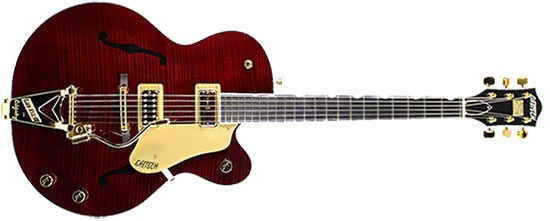
| Finish | Dark Cerise Natural |
| Years Used | 1959 to 1996 |
After almost half a decade tenure with his exclusive and superb paradigm, Chet got his hands on an updated version of his signature Country Gentleman guitar equally a courtesy from Gretsch. As expected, this instrument was also some other "platform" for Chet's innovation and musical experimentation.
The first noticeable change was the instrument's appearance. Although its body shape and overall design were kept from the original Country Admirer prototype, the cutting on the body became slightly flatter yet somehow larger. Furthermore, Gretsch's approach to this enhanced version was a lot simpler "Less is more".
Information technology included a newer variant of a Bigsby tremolo tailpiece, the 1 we know present as an industry staple. Secondly, the guitar has legendary Filter'Tron pickups, designed by legendary Ray Butts. At that place'south besides a directly bar bridge, a more straightforward pickguard, also as a more than elaborate paint task and binding.
The finish on this instrument was a scrap different. Although with basic natural wood aesthetics, it came with a nighttime cherry-red color, kind of similar to the classic cherry cherry Gibson is known for. Additionally, it had smaller F-shaped soundholes which gave this guitar a more elegant look. But, what's really interesting, the guitar had a zero fret. This helped with tuning stability, intonation, and even sustain.
It didn't take long for this musical instrument to become one of Chet'due south almost important guitars. Sure, it wasn't every bit prominently used as the original Country Gentleman, but information technology was still his trusty companion over the years, appearing on countless recordings and live shows.
D'Angelico Excel
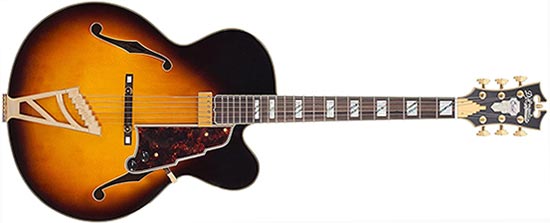
| Stop | Vintage Sunburst |
| Years Used | 1944 to Unspecified |
Before getting in bear on with Gretsch, Chet frequently used his D'Angelico Excel guitar. It was one of the instruments that saw his rise to prominence as "Mr. Guitar". He played this six-cord in his audition for Ruby-red Foley, who was leaving his star position on WLS-AM'due southNational Barn Dance to join the 1000 Ole Opry. It was so at the 1946 Opry that Chet would finally strike luck in the music business organisation.
Of course, this is yet some other hollow-trunk jazz-oriented guitar. Just like today, D'Angelico has always had some pretty high-terminate instruments. Even though it weirded some musicians at the time, Chet modified the instrument. However, this would set some new standards, highlighting a pioneering quality on Atkins. Today, this would be the perfect vintage guitar. Only back then in the early on 1950s, information technology was pretty unorthodox to take such an instrument. What'due south more, some would take even argued that he "butchered" information technology, despite the six-string working in his favor.
Of grade, this was another single-cutaway hollow-body instrument. Only Chet made a custom order with a tremolo tailpiece. And, every bit if that wasn't enough, he modified information technology on his own. The instrument came with a Bigsby pickup in the bridge. It wasn't until subsequently he was done modifying information technology, the guitar ended upward with the Bigsby pickup in the neck position and a P90 pickup in the bridge position. Along with this, Chet likewise added a 3-way toggle switch.
This was his main guitar before getting his easily on his ever-iconic Gretsch, the original State Gentleman. During this time, he was a pretty prolific session guitarist. Nigh notably, he had it while performing with the Carter Sisters. The story goes that June Carter accidentally damaged the musical instrument, ultimately separating the torso and the neck. The guitar was repaired years subsequently. It is believed that this happened around the time when Chet switched over to his Gretsch.
Gibson Chet Atkins Country Admirer
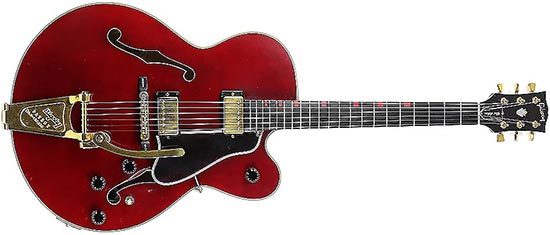
| Stop | Natural Dark Red |
| Years Used | 1980 to 1996 |
When Gretsch started growing, Chet eventually started to dislike the new direction that the company was taking. The dissatisfaction was so big that he withdrew the license to allow them to sell products with his name on them. So he went over to Gibson. This was erstwhile around the late 1970s or the early on 1980s. Later on striking a bargain, the visitor started making a guitar model that was rather similar to the onetime Gretsch variant.
The model was available commercially for a while. However, these were some pretty high-terminate instruments. Even to this day, they retain a pretty high toll among collectors.
Although similar to the Gretsch Land Gentleman, in that location are some significant differences with the Gibson variant. Most notably, information technology came with Gibson's classic 490 humbucker pickups. It likewise had a scale of 25.5 inches, which is somewhat unusual for Gibsons. So we also have a much narrower body, only 1.75 inches.
It also came with a Bigsby tremolo tailpiece and a tune-o-matic bridge on a rosewood base. The trunk too comes with binding on the edges and effectually the F-shaped soundholes, giving it a very stylish look. Additionally, it too came with an armrest, which made it stand out. This is easily i of the near iconic Chet Atkins guitars of all time.
Peavey T-60 aka "Peaver"
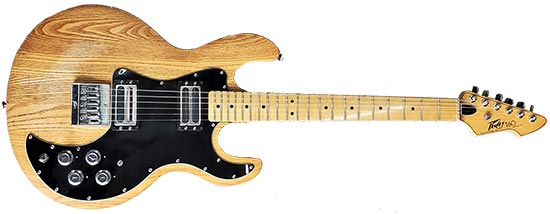
| Cease | Crimson Red/Natural |
| Years Used | 1983 to 1994 |
Ane of Chet Atkins' "Frankenstein," guitars. The torso and bones features are that of Peavey's T-lx. Although not much info is available on this 6-string, certain sources claim that he used information technology on about a dozen of songs from the early 1980s to the mid-1990s.
The instrument was reportedly put together by Chet's friend Paul Yandell. However, its afterward whereabouts, after the mid-1990s aren't known. In that location was an endeavour to start making the "Peaver" model nether the Gibson brand. But later only a handful of copies, the project was abased.
The instrument's torso was from a Peavey T-threescore. This is a weird-looking double-cutaway guitar, featuring a night cerise finish, that was somewhen peeled to its natural limerick. The cutaways are slightly uneven in length and the body is slightly offset. Only, interestingly plenty, the instrument came with a Fender Stratocaster neck. It appears to exist from a 1960s Strat every bit it doesn't feature a maple fingerboard. It came with ii single-curl pickups, one in the bridge and another on in the eye. These were allegedly EMG single-coils. There was also a phase switch on the musical instrument.
Del Vecchio Dinâmico

| Finish | Natural |
| Years Used | Unspecified |
Of course, Chet was too really into acoustic guitars, doing some of the best works on them. But let'southward start off with a bottom-known ane in his collection. The instrument in question is Del Vecchio Dinâmico. Del Vecchio is an old traditional manufacturer. And their Dinâmico was a pretty popular resonator guitar model.
As for Chet'southward utilize of the instrument, we tin can't say for certain where exactly this guitar appeared over the years. However, he did appear alive with it at least a few times.
The story goes that Chet was amazed by this instrument model after hearing Nato Lima De Los Indios Tabajaras duo. These instruments are pretty rare and they're still highly valued amongst collectors. As for Chet'southward guitar, its afterward whereabouts are non certain.
Hither we have a standard wooden resonator guitar on our hands. It's what some would refer to equally a "dobro" guitar. And being rare, it's unremarkably hard to give precise info on the specs.
All the same, it'southward known that these guitars have 24.v-inch scale lengths and 2-inch-wide nuts. Information technology also comes with a "biscuit" bridge. Overall, the instrument is a existent masterpiece.
Gibson Chet Atkins CE
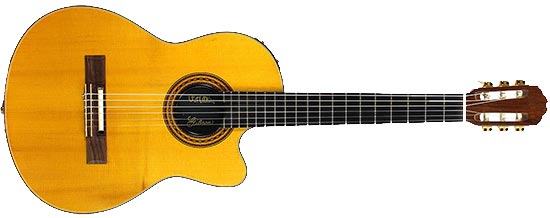
| Stop | Natural |
| Years Used | 1982 to 1996 |
These were released sometime in 1982, which is the same time when he began using them too. In fact, the Studio Classic nylon-cord pretty much became the Chet Atkins signature model even though the model itself predates the collaboration.
The instrument as well included electronics, and the "CE" stands for "Classical Electric." On this instrument, Chet and Gibson too collaborated with luthier Kirk Sand. There accept been some changes in the body chambers and pickup design.
Although an acoustic guitar, the body is pretty thin and information technology kind of feels like a solid-body electric. The primary thought was to accept a classical guitar that wouldn't get that annoying feedback on stage. At the same time, you could play information technology acoustically.
The instrument as well came with specially designed piezo pickups and electronics. If you were to expect at the back of the guitar, the electronics compartment resembles that one of a Gibson Les Paul.
The torso's top was made out of spruce while the sides, dorsum, and the main structure were from mahogany. It too featured a mahogany neck. It also had a longer scale length, a chip longer than 25 inches.
Gibson L-10

| Finish | Sunburst |
| Years Used | 1956 to 1996 |
It's highly probable that Chet's first contact with Gibson was dorsum in the 1950s when he acquired an old sunburst Fifty-10. This archtop guitar was given to him by his half-blood brother Jim. And Jim got information technology from no other than the legend himself, Mr. Les Paul. The instrument also had a lot of sentimental value to Chet. Just, only like it goes for nigh of his guitars, Chet modified it.
Unfortunately, this instrument had an blow when Chet fell over it, severely damaging the torso. Although information technology was repaired, he could never get the aforementioned tone from it always again.
Most notably, this musical instrument was custom ordered past Les Paul and information technology had an extended scale length. Information technology'southward non certain how long it actually is, but information technology'due south probably over 25 inches. As for Chet'due south modifications, he added a Vibrola tailpiece, equally well equally a floating DeArmond pickup.
Timetable Showing Each Guitar Chet Atkins Played Throughout His Career
Chet Atkins Amps Overview
Gretsch Chet Atkins Piggyback
Years Used: 1960s to Present
It's hard to find concrete information on all amps that Chet Atkins has used over the years. However, it's known that he used a Gretsch amplifier, his 6161 signature model, the so-called "piggyback."
This was a stack, featuring an amp caput with a maximum output power of 140 watts. The cabinet included 2 speakers, one that'southward 12 inches in diameter and the other that's 15 inches. The 12-inch one was for the Reverb and Tremolo aqueduct, while the 15-inch one was for the other channel with boosted bass. It besides featured six preamp tubes and four power amp tubes.
1954 Standel 25L15 Philharmonic
Years Used: 1950s to Unspecified
Although it's hard to find info on the verbal gear that Chet used and when he used it, his friend Paul Yendell revealed an amp that plant its way on virtually of the guitarist's recordings. The unit in question is a Standel 25L15, a philharmonic amplifier manufactured mode back in 1954. This one was very popular among country players of the era, including Merle Travis.
Information technology'southward a pretty rare tube amplifier with a pair of 807 tubes in the power amp section. It'due south a pretty rare sight for today's standards, although these are still manufactured and are virtually unchanged compared to the onetime models. As expected, these are "boutique"-tier high-cease units with a tone somewhat similar to old Fender amps.
Chet Atkins Pedals and Furnishings Overview
Custom-Made Record Echo
Years Used: 1954 to 1996
Designed past Ray Butts, the engineer who developed the outset humbucking pickup, Filter Tron. Yet, he was also into record-based echo devices, somewhen developing his EchoSonic amplifier with an integrated echo effect.
The amp came with 6V6 or 6L6 power amp tubes. It also featured a total output power of 15 watts. But its biggest advantage was its size, which was relatively smaller compared to other devices at the time. Other than that, it as well featured 12AU7, 12AX7, and 12AY7 tubes in the preamp section.
Dorsum then, this was one of the rare options for creating a decent repeat effect. Aside from that, Chet also used other methods to accomplish reverb and echo, including utilizing empty lift shafts for recording sessions.
Lexicon JamMan PCM41
Years Used: During the 1990s
Chet Atkins continued performing well into the 1990s. Although an old-school guitar actor, he kept up with the newer technology. One of the effects units that he used back then was the JamMan PCM41, manufactured by Lexicon.
This is an repeat and looper device in 1, designed equally a rack-mounted unit of measurement. Notwithstanding, it still came with a footswitch and all the necessary detailed controls. The device was pretty advanced for the times, even featuring MIDI connectivity that would allow information technology to become synced with a pulsate machine or whatsoever other MIDI-supported device.
Echoplex
Years used: 1950s to Unspecified
Later on the success of Ray Butts' EchoSonic device, an engineer named Mike Battle adult a standalone tape echo device, carve up from the tube-driven guitar amp. Appropriately named Echoplex, it was obvious that Chet Atkins was going to get his easily on one of these. The same could exist said of some other guitar legends of the era, including Carl Perkins, and Scotty Moore.
These original units were completely tube-driven. Later iterations featured solid-land design. All the same, those with tube circuitry are still highly valued amongst collectors due to their warmer tone. In a matter of years, Jim Dunlop became inspired by this particular pattern to build his own version of it.
Wrap Up
Chet Atkins impacted jazz, dejection, pop, rock, and even metal musicians. Believe it or not, his discography includes a total of 58 albums and many collaborations. Atkins' showtime full-length record was released way back in 1953, and his final ane, titled "Solo Sessions," came out in 2003, two years after his passing.
He's the only man that worthy enough of the nickname "Mr. Guitar." he wasn't always a rock star as one would expect. He was a very modest musician, well-known for his incredible fingerpicking and some of the almost interesting arrangements, mixing state, jazz, and blues music.

My name is Chris and I've had a passion for music and guitars for as long equally I can call back. I started this website with some of my friends who are musicians, music teachers, gear heads, and music enthusiasts then we could provide loftier-quality guitar and music-related content.
I've been playing guitar since I was 13 years old and am an gorging collector. Amps, pedals, guitars, bass, drums, microphones, studio, and recording gear, I love it all.
I was born and raised in Western Pennsylvania. My background is in Electrical Engineering, earning a Bachelor's degree from Youngstown State University. With my engineering experience, I've adult as a designer of guitar amplifiers and effects. A true passion of mine, I've designed, congenital, and repaired a wide range of guitar amps and electronics. Here at the Guitar Anteroom, our aim is to share our passion for Music and gear with the rest of the music community.
Source: https://www.guitarlobby.com/chet-atkins-guitars-and-gear/
Post a Comment for "What Kind of Electric Guitar to Play Like Chet Atkins"